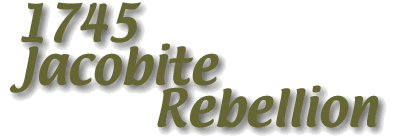|
Clothing for Scottish
men of the mid 18th Century was divided between Highland dress and everything
else. Scottish men not in Highland dress wore (depending upon class)
what the rest of Europe wore, occasionally with a tartan accent.
Not all men in the Jacobite army regularly wore Highland clothing.
Many men were not even Scottish Highlanders. This document addresses
Scottish Highland clothing. Consult with your Clan or unit about
your character’s clothing needs.
Men wore loose fitting white or off white linen (or cotton, rarely) shirts,
hanging to mid thigh. No patterned, printed, or bright colored shirts
have been documented, please do not wear them. These
shirts were open, or buttoned with loops or button holes at the neck and
cuffs. Shirts did not lace up like shoes or have metal grommets
at the neck, and often fastened between the legs with a button or tie.
Shirts doubled as underwear, slips, and nightshirts for many men
of the period.
Over the shirt were worn belted plaids (known also as great kilts), or
kilts (one half of a belted plaid, lengthwise), or trews (the combination
of thigh-high bag socks and shorts, made of tartan wool.) The belted
plaid or great kilt consists of from four to six yards of roughly 60 inch
material (originally two pieces of 20 to 30 inch wide fabric sewn lengthwise.)
It is worn with hand folded pleats, and is belted, tied, or pinned into
place. The belted plaid was your overcoat, pants, rain gear, blanket,
tent, backpack, and fire damper. It is one of the most utilitarian
garments every invented. Circular brooches for fastening the great
kilt at the shoulder were still in use, but the ones with great big stones
are Victorian foofaraw. Please do not wear modern kilt pins
to keep the skirt’s overlap closed. Small kilts were also
hand pleated, or had tacked-in box pleats 3 to 6 inches wide. Do
not wear modern kilts.
Most Highland men wore waistcoats, and a wool coat or jacket. Highland
waistcoats and jackets were often cut shorter than mid 18th Century fashion
so they could be worn with a belted plaid or kilt. Waistcoats were often
a few inches longer than the Highland jackets and both were commonly different
tartans. Short waistcoats and jackets, plain or tartan, were also
seen in the working classes, worn with trews or breeches. Animal
skins with the hair on them were rarely seen as dress items in the mid
18th Century. A neck stock or neckerchief was worn, as much for protection
against sword blades as it was fashion. A lace jabot and cuffs were
often seen on gentlemen. The use, quality, and design of some of
these items was class sensitive.
Aside from weapons [SEE WEAPONS AND BATTLE RE-ENACTMENTS],
a belt and sporran (leather purse or bag hung on your belt) complete the
traditional Highland outfit. The sporran is a simple leather pouch
in which is carried money and small items, as there are no pockets in
a kilt. Expensive, fancy sporrans are inappropriate for most Highlanders.
Do not wear modern sporrans.
With kilts many Highland men either went barefoot, or wore gillies (an
open, roman-like shoe) with up-the-calf ties. Shoes were usually
simple brogues which tied or, if you had money, buckled. The
brogues would be worn with wool bag socks, seamed up the back, and tied
on. Gillies were also sometimes worn with bag socks. Wool leggings
(like footless knee socks) were occasionally worn, with or without gillies.
Riding boots may be worn with trews, but boots were not worn with kilts.
Knit stockings were uncommon and strongly resisted in the Highlands until
the 19th Century. Class played a large part in footwear. Please
avoid modern kilt socks or boy scout type socks.
As with women, upper class gentlemen wore a wider variety of clothing,
of a better grade, and more in tune with the fashions of the day.
The Highland bonnet was a very important item of clothing in a man’s
wardrobe. Bonnets were predominantly blue wool, sometimes dark green
or dark red, and were not made of tartan. They were usually worn
flat on the head and not at a great rakish angle. Bonnets in 1745
were generally at least 12 inches across and did not resemble modern golf
hats. Bonnets should be decorated as follows:
Politics - white cockade (ribbon or fabric in a bow or rose shape)
for Jacobites, worn in front.
Clan - a sprig of your Clan’s plant badge identifies you.
Worn in front.
Feathers - worn only by chiefs, sub-chiefs, cadets, or senior Clan officials
in some clans.
Boss - (the wool pom-pom) rare, possibly occasionally worn by those
in military. command positions so they can be identified from behind
by the men following them.
Metal Clan badges - not worn in the 18th Century.
|

